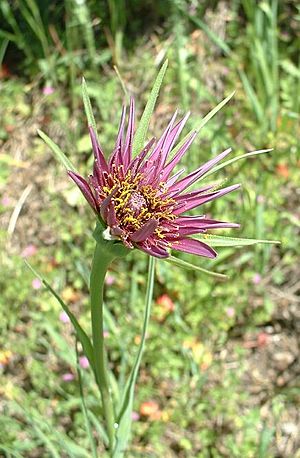Goatsbeards facts for kids
Quick facts for kids Goatsbeards |
|
|---|---|
 |
|
| Purple salsify (Tragopogon porrifolius) |
|
| Scientific classification |
|
| Kingdom: | Plantae |
| Clade: | Tracheophytes |
| Clade: | Angiosperms |
| Clade: | Eudicots |
| Clade: | Asterids |
| Order: | Asterales |
| Family: | Asteraceae |
| Subfamily: | Cichorioideae |
| Tribe: | Cichorieae |
| Subtribe: | Scorzonerinae |
| Genus: | Tragopogon L. |
| Type species | |
| Tragopogon porrifolius |
|
| Synonyms | |
|
Chromopappus Boriss. |
|
Tragopogon, also known as goatsbeard or salsify, is a group of flowering plants. They belong to the Asteraceae family, which also includes daisies and sunflowers. This group of plants includes a popular vegetable called salsify, as well as many common wild flowers.
Salsify plants are usually biennial (meaning they live for two years) or perennial (meaning they live for more than two years). They have a strong main root, like a carrot, and a milky sap inside their stems. These plants usually don't have many branches, and their stems tend to grow straight up. Their leaves look a bit like grass.
The flowers of salsify plants can be different colors, including yellow, bronze, or purple. After the flowers bloom, they produce seeds. These seeds are carried by the wind, much like dandelion seeds, but they are larger.
Most salsify plants originally came from Europe and Asia. However, several types have been brought to North America and Australia, where they have spread widely. One species, Tragopogon mirus, was once thought to be native to North America. But scientists later found out it's actually a mix of two other types of salsify that weren't originally from there.
Some common types of Tragopogon are simply called "goat's beard" or "salsify." This can be confusing because these names are used for many different species. It's often better to use these names for the whole group of plants, rather than for just one specific type.
The vegetable called salsify is usually the root of the purple salsify, Tragopogon porrifolius. People say its root tastes a bit like oysters, but milder and slightly sweet. That's why it's sometimes called the "oyster plant". You can also eat the young shoots and leaves of purple salsify. Other types of salsify can be eaten too. There's also a plant called black or Spanish salsify, Scorzonera hispanica. It's related to Tragopogon but is in a different plant group.
How New Species Form
Salsify plants are a great example of how new plant species can form through a process called hybrid speciation. This happens when two different species mix their genes to create a brand new species.
In the early 1900s, three types of goatsbeard were brought to North America by people. These were the western salsify (T. dubius), the meadow salsify (T. pratensis), and the oyster plant (T. porrifolius). Today, you can often find these plants growing in cities.
Around the 1950s, plant scientists discovered two new species in Idaho and Washington. These new species appeared in areas where the three original types of salsify grew close together.
- One new species, Tragopogon miscellus, is a tetraploid hybrid. This means it got two full sets of chromosomes from each of its parents. Its parents were T. dubius and T. pratensis.
- The other new species, Tragopogon mirus, is also a allopolyploid. Its parents were T. dubius and T. porrifolius.
These new species are often called "the Ownbey hybrids" after the botanist who first described them. The T. mirus plants mostly reproduce among themselves. However, new T. mirus plants are still being created when T. dubius and T. porrifolius cross-breed. This shows that new species can continue to form through hybridization.
Species of Salsify
There are many different types of Tragopogon plants around the world. Here are a few examples:
- T. dubius – known as western salsify or yellow goat's beard.
- T. floccosus – called woolly goatsbeard.
- T. hybridus – known as pasture goatsbeard.
- T. lamottei – sometimes called jack-go-to-bed-at-noon.
- T. mirabilis – known as Ontario goatsbeard.
- T. mirus – called remarkable goatsbeard.
- T. miscellus – known as hybrid goat's-beard or Moscow salsify.
- T. porrifolius – the purple salsify or oyster plant, often grown as a vegetable.
- T. pratensis – also called jack-go-to-bed-at-noon or meadow salsify.
Images for kids
See also
 In Spanish: Tragopogon para niños
In Spanish: Tragopogon para niños


